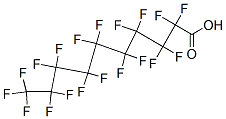-
Name
PERFLUORODECANOIC ACID
- EINECS 206-400-3
- CAS No. 335-76-2
- Density 1.759 g/cm3
-
Solubility
9.5 g/l at 25 C
Stability
- Stable. Incompatible with strong bases, oxidizing agents, reducing agents.
Toxicology
- Toxic if swallowed. Eye, skin andrespiratory system irritant.
- Melting Point 77-81 ºC
- Formula C10H F19 O2
- Boiling Point 219 ºC
- Molecular Weight 514.086
- Flash Point 82.7 ºC
- Transport Information
- Appearance white crystalline powder
- Safety Poison by ingestion and intraperitoneal routes. An experimental teratogen. Experimental reproductive effects. Mutation data reported. When heated to decomposition it emits toxic fumes of F−.
- Risk Codes 25-36/37/38
-
Molecular Structure
-
Hazard Symbols
 T
T C
C
- Synonyms Decanoicacid, nonadecafluoro- (6CI,7CI,8CI,9CI); Nonadecafluoro-n-decanoic acid; Nonadecafluorodecanoicacid; Perfluoro-1-nonanecarboxylic acid; Perfluoro-n-decanoic acid;Perfluorocapric acid; Perfluorodecanoic acid
- PSA 37.30000
- LogP 5.71570
Toxi
Perfluorodecanoic acid Chemical Properties
IUPAC Name: 2,2,3,3,4,4,5,5,6,6,7,7,8,8,9,9,10,10,10-Nonadecafluorodecanoic acid
Synonyms: Decanoic acid, 2,2,3,3,4,4,5,5,6,6,7,7,8,8,9,9,10,10,10-nonadecafluoro- ; 2,2,3,3,4,4,5,5,6,6,7,7,8,8,9,9,10,10,10-Nonadecafluorodecanoic acid ; Decanoic acid, nonadecafluoro-
Product Categories: Fluorous Chemistry;Fluorous Compounds;Synthetic Organic Chemistry
CAS NO: 335-76-2
Molecular Formula:C10HF19O2
Molecular Weight:514.08
Molecular Structure:
EINECS: 206-400-3
Index of Refraction:1.288
Surface Tension: 16.4 dyne/cm
Density: 1.759 g/cm3
Flash Point: 82.7 °C
Enthalpy of Vaporization: 50.17 kJ/mol
Boiling Point: 219 °C at 760 mmHg
Vapour Pressure: 0.0463 mmHg at 25°C
Melting point: 77-81 °C(lit.)
Storage temp: 2-8°C
Stability: Stable. Incompatible with strong bases, oxidizing agents, reducing agents.
Appearance:white crystalline powder
Perfluorodecanoic acid Toxicity Data With Reference
| Organism | Test Type | Route | Reported Dose (Normalized Dose) | Effect | Source |
|---|---|---|---|---|---|
| guinea pig | LD50 | intraperitoneal | 150mg/kg (150mg/kg) | Toxicologist. Vol. 1, Pg. 16, 1981. | |
| hamster | LDLo | intraperitoneal | 100mg/kg (100mg/kg) | BEHAVIORAL: FOOD INTAKE (ANIMAL) | Fundamental and Applied Toxicology. Vol. 9, Pg. 522, 1987. |
| mouse | LD50 | intraperitoneal | 150mg/kg (150mg/kg) | Toxicologist. Vol. 1, Pg. 16, 1981. | |
| mouse | LD50 | oral | 111mg/kg (111mg/kg) | Fundamental and Applied Toxicology. Vol. 13, Pg. 723, 1989. | |
| rat | LD50 | intraperitoneal | 40mg/kg (40mg/kg) | Toxicologist. Vol. 1, Pg. 16, 1981. | |
| rat | LD50 | oral | 57mg/kg (57mg/kg) | BEHAVIORAL: FOOD INTAKE (ANIMAL) | Toxicology and Applied Pharmacology. Vol. 85, Pg. 169, 1986. |
Perfluorodecanoic acid Consensus Reports
Reported in EPA TSCA Inventory.
Perfluorodecanoic acid Safety Profile
Poison by ingestion and intraperitoneal routes. An experimental teratogen. Experimental reproductive effects. Mutation data reported. When heated to decomposition it emits toxic fumes of F−.
Hazard Codes T,
T, C
C
Risk Statements 25-36/37/38
R25 :Toxic if swallowed.
R36/37/38:Irritating to eyes, respiratory system and skin.
Safety Statements 26-45
S26: In case of contact with eyes, rinse immediately with plenty of water and seek medical advice.
S45:In case of accident or if you feel unwell, seek medical advice immediately (show the label whenever possible.)
RIDADR UN 2811 6.1/PG 2
WGK Germany 3
RTECS HD9900000
Hazard Note Corrosive
TSCA T
HazardClass 6.1
PackingGroup III
Perfluorodecanoic acid Specification
Reactivity Profile : Perfluorodecanoic acid is incompatible with strong oxidizing agents.
Health Hazard :ACUTE/CHRONIC HAZARDS: Decomposition products of Perfluorodecanoic acid include carbon monoxide, carbon dioxide, and hydrogen fluoride. It may be harmful by inhalation, ingestion, or skin absorption.
Related Products
- Perfluorodecanoic acid
- 33577-16-1
- 33577-98-9
- 33580-59-5
- 33581-77-0
- 33581-98-5
- 3358-28-9
- 335-83-1
- 33584-60-0
- 33586-66-2
- 33588-54-4
Hot Products
About|Contact|Cas|Product Name|Molecular|Country|Encyclopedia
Message|New Cas|MSDS|Service|Advertisement|CAS DataBase|Article Data|Manufacturers | Chemical Catalog
©2008 LookChem.com,License: ICP
NO.:Zhejiang16009103
complaints:service@lookchem.com Desktop View